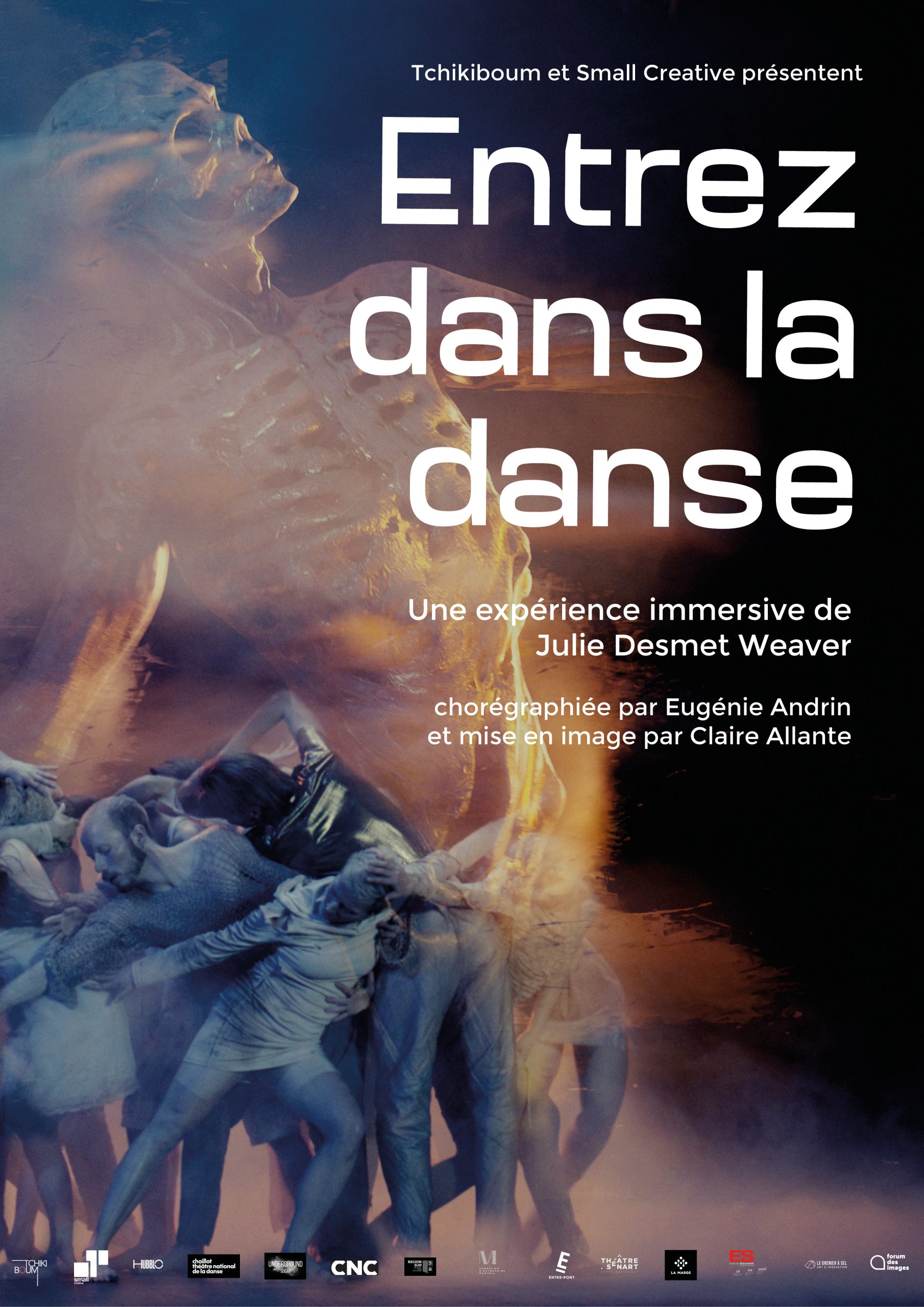
THE DANCING PLAGUE
30 min
Licensing

A living and fantastical fresco, one you might just step into yourself…
The Dancing Plague is a unique experience inspired by a sadly famous event: the Dancing Plague epidemic of 1518. Inside a dome, the public is invited to discover the story of Enneline, the first woman to be swept away by this pandemic. Combining theater and dance, this sensory experience invites us to follow the momentum of the bodies, bearing witness to the distress of a population in the grip of extreme poverty and rigid authorities. Borrowing from live performance and cinema, the experience becomes a veritable playground for spectators, who are invited to enter into the dance, thanks to an immersive, interactive device. This resolutely modern story offers audiences a different way of looking at movement, one in which they can gradually become part of a collective dance experience.
AWARDS AND FESTIVALS
⎯⎯⎯⎯⎯⎯⎯⎯⎯⎯⎯⎯⎯⎯⎯⎯⎯⎯⎯⎯⎯⎯⎯⎯⎯⎯
- SELECTION International Experience | Cardiff FullDome Festival, United Kingdom (2023)OFFICIAL
- OFFICIAL SELECTION | Best of Earth (2025)
- OFFICIAL SELECTION | Fort Myers Film Festival (2025)
CREDITS
⎯⎯⎯⎯⎯⎯⎯⎯⎯⎯⎯⎯⎯⎯⎯⎯⎯⎯⎯⎯⎯⎯⎯⎯⎯⎯
Directed by
Julie Desmet Weaver
Choregraphed by
Eugénie Andrin
Visual creation
Claire Allante
Visual composed by Claire Allante
Music composed by
CYCHOTOMY
From the Dance of Death of
Camille Saint-Saëns
Produced by
Tchikiboum
Small Creative
From the novel of
Jean Teulé - Éditions Julliard
WITH
⎯⎯⎯⎯⎯⎯⎯⎯⎯⎯⎯⎯⎯⎯
Joséphine Terme
Marie-Pierre Génovèse
Jonathan Genet
Blandine Laignel
Axel Neaumont
Gloria Arar Sargent
Serge Lazar
WITH THE PARTICIPATION OF
⎯⎯⎯⎯⎯⎯⎯⎯⎯⎯⎯⎯⎯⎯
Les apprentis du CFA Danse
Chant
Comédie de Paros
L'Académie Internationale de la danse
SUPPORTED BY
⎯⎯⎯⎯⎯⎯⎯⎯⎯⎯⎯⎯⎯⎯
CNC
Région Sud
L'Entre-Pont Nice
Fondation Martell
WITH THE SUPPORT OF
⎯⎯⎯⎯⎯⎯⎯⎯⎯⎯⎯⎯⎯⎯
Hubblo
Underground Sugar Company
Chaillot
National Theater of Danse
La Marge - Lieusaint
Senart Theater
Distributor
Hubblo










WORDS FROM THE DIRECTOR AND CHOREGRAPHER
⎯⎯⎯⎯⎯⎯⎯⎯⎯⎯⎯⎯⎯⎯⎯⎯⎯⎯⎯⎯⎯⎯⎯⎯⎯⎯
« To create this 360° immersive experience, which recounts the episode of the dancing epidemic of 1518 and the story of the couple Enneline and Melchior, I drew my inspiration from the dances macabre of the Middle Ages and those long, joyful farandoles that never end. By bringing together under a single 360° dome the filmed bodies of the performers, the motion-captured virtual bodies of the skeletons and the carnal bodies of the spectators, I'd like to initiate a continuous, circular movement: a festive round, questioning our ancestral, instinctive and organic fears in the face of death.
My aim is to illustrate the vertigo provoked by the imbalance of the men and women in this political tale (?), to recount this dangerous swaying, this oscillation of bodies that gradually recognize and respond to each other in unison, before tipping over entirely into a dark carnival. Re-interrogating the place of bodies at the heart of the city. »
- Julie Desmet Weaver, director
« The choreography shows the slide from a light, joyful dance into the hell of an obligatory farandole. Foot tapping to a haunting rhythm, dislocated limbs, suffocating bodies, crowds of people, incessant whirling... all express the ambiguity between the comfort of trance as an escape and the pain of a dance that leads to exhaustion.
The dancers involved in the experiment each have a strong and unique physical and choreographic signature that it seems essential to preserve, in order to avoid any formatting that a common technique might have inoculated. In fact, their singularity is a precious asset, which should be highlighted so as not to interfere with the natural movement of the dancers. For it was instinctively, without any rules, that the crazed inhabitants began to dance. »
- Eugénie Andrin, choregrapher






Julie Desmet Weaver
Director/
Julie Desmet Weaver is a multidisciplinary French artist, trained in theater and dance, who explores the connections between performing arts and immersive technologies. She is the founder of the company Underground Sugar and stands out for her innovative creations that combine theater, virtual reality, and performance art.
Her work The Dancing Plague, created in collaboration with Eugénie Andrin and Claire Allante, is a 360° immersive experience inspired by the dancing plague of 1518. It merges contemporary dance, motion capture, and an interactive installation within an immersive dome, inviting spectators to become active participants in the performance. This project reflects her desire to rethink artistic forms by integrating digital technologies to question our relationship with the body, collective memory, and trance.
Her aim is to convey the vertigo caused by the imbalance of the men and women in this political narrative—to tell the story of that dangerous swaying, that oscillation of bodies which gradually recognize and respond to one another in unison, before fully tipping into a dark carnival. It is a way to re-examine the place of bodies at the heart of the public space.
Eugénie Andrin
Choregrapher
Eugénie Andrin is a French choreographer and dancer, trained at the Rosella Hightower School and a former soloist with the Ballet of the Opéra d’Avignon. She founded her own company in 2007 and is recognized for her creations that blend contemporary dance, opera, and participatory projects.
In The Dancing Prague, Eugénie Andrin brings a sensitive and expressive choreographic language, integrated into an immersive reality environment where filmed bodies engage in a dialogue with the audience. Her contribution enhances the sensory and collective dimension of the experience, exploring states of trance, contagion, and liberation through movement.


Claire Allante
Artistic Director
The story begins in a stifling atmosphere. A strange fog fills both interiors and streets. Occasional shafts of light cut through windows and buildings, outlining silhouettes. This disturbance of reality signals a dark omen from the very start of the narrative.
As the story unfolds, the image begins to deteriorate. Like old film reels corroded by chemicals and time, an organic texture starts to erode the settings and the bodies. In the final part, a chaotic effect emerges through the layering of images—an explosion of supernatural colors, referencing rave parties.

